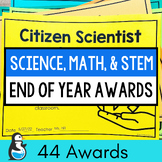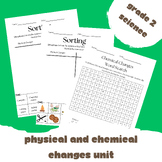91 results
Physics graphic organizers for Microsoft Word
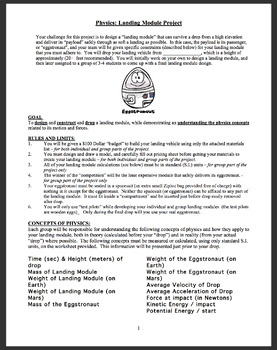
Mars Landing Module STEM Challenge (Egg Drop) - Middle or High School Physics
This is a multi-step, usually multi-week Engineering Project that I did in 8th grade physics class for many years, and it was ALWAYS super fun and a highlight of the year. It accompanies a Physics Unit on Mass, Forces, Gravity, and KE & PE Energy, and is best to incorporate project into a 4-6 week unit. It can easily be adapted for grades 6-12, varying the concepts of physics that are expected to be demonstrated.The students design a "landing module" to theoretically land on Mars, while succ
Subjects:
Grades:
7th - 10th
CCSS:
NGSS:
MS-ETS1-2
, MS-PS3-2
, MS-ETS1-1
, MS-ETS1-3

Waves of Energy: Comparing Tsunami and Earthquake Waves Webquest
NGSS aligned web activity, students learn more about the physics of seismic and tsunami waves in order to make observations on how these compare to each other and wind driven ocean waves. How does the medium affect the frequency, amplitude and velocity? How does energy travel through these waves?Hyperlinks are provided on the three wave topics (wind, seismic and seismic tsunami waves) for students to conduct independent research in order to complete the comparison chart. Multiple resources pr
Subjects:
Grades:
8th - 12th
NGSS:
HS-PS4-1

Light Unit Labs, Guided Readings, Graphic Organizers and Teacher Notes
Here is a complete unit on light perfect for your chemistry, physics, or astronomy unit for Middle School SciencePRODUCT CONTAINSLabsGuided ReadingTeacher notesGraphic organizersMATERIALSClear Plastic cupClear square containerWater in a pitcher1 Compact disc such as a music CD1 Piece of white copy paperCamera or colored pencils or crayonsPencil1 clear drinking glass (try one made of clear glass first)WaterMilkSpoonEyedropperBright flashlightAny handheld remote controls from around the house (TV
Subjects:
Grades:
7th - 9th
NGSS:
MS-PS4-2

Nuclear chemistry
Use this graphic organizer to summarize the most important takeaways from Nuclear Chemistry - fission vs. fusion; alpha, beta & gamma decay; history and medical uses of nuclear chemistry. Use the practice problems attached along with to practice decay equations.
Subjects:
Grades:
8th - 12th, Higher Education, Adult Education
NGSS:
HS-PS1-8
Also included in: Nuclear Chemistry
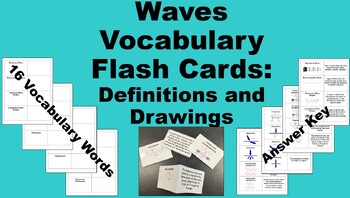
Waves Vocabulary 16 Flash Cards: Write Definitions, Draw Examples, Answer Key
This resource is 16 Waves Vocabulary Flash Cards. Through this resource students will: (1) Research the definitions of 16 Waves Vocabulary Words, (2) Determine and Draw picture examples of each Waves Vocabulary Word, and (3) Cut out and Assemble their Waves Vocabulary Flash Cards.This resource is 10 Pages. Pages 1-4: Student Handout for Waves Vocabulary Flash Cards. These are the pages students will fill out and cut out to make the Flash Cards. Pages 5-8: Answer Key for Waves Vocabulary F
Subjects:
Grades:
6th - 12th
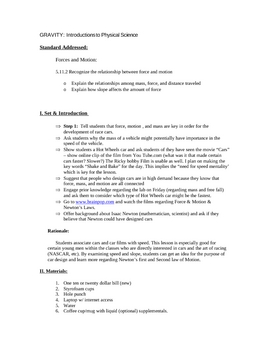
Fun Intro. to Physical Science Lesson Plan w Lab Worksheet
This is a thoroughly written formal lesson plan on how to introduce the principles of Physical Science and the work of Newton. This includes a step-by-step lab experiment and fun worksheet for individual or group work. Also, as a bonus, it includes a link to short stories for writing about Newton's work.
Subjects:
Grades:
2nd - 10th

Nuclear Reactor
This is an interactive downloadable to help students understand the parts of a nuclear reactor while understanding the flow and type of energy at each step. You can use this worksheet to explain the conversion of energy from chemical to thermal to mechanical to finally electrical energy.
Subjects:
Grades:
8th - 12th, Higher Education, Adult Education
NGSS:
HS-PS1-8
Also included in: Nuclear Chemistry
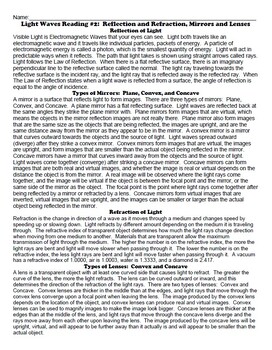
Light Waves Reading #2: Reflection and Refraction, Mirrors and Lenses
This resource is a Read, Think, and Draw of Light Waves Reading #2: Reflection and Refraction, Mirrors and Lenses. Through the reading students will learn about: Electromagnetic Waves, Visible Light, Photons, Light Rays, Light Rays Travel In Straight Lines Until Interacting with Matter, Law of Reflection, Real Images (Formed When Light Rays Converge, Concave Mirror, Convex Lens) , Virtual Images (Formed When Light Rays Diverge, Plane Mirror, Convex Mirror, Concave Lens), Types of Mirrors (Plane,
Subjects:
Grades:
6th - 12th
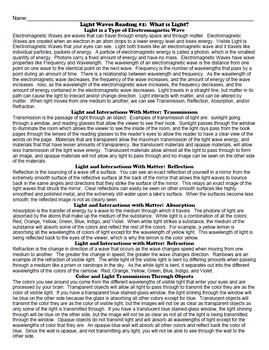
Light Waves Reading #1: What Is Light- Read, Think, and Draw
This resource is a Read, Think, and Draw of Light Waves Reading #1: What is Light?. Through the reading students will learn about: Electromagnetic Waves, Visible Light, Photons, Wavelength, Frequency, Interactions of Light With Matter, Wave Energy, Transmission of Light (Transparent, Translucent, Opaque), Reflection of Light, Absorption of Light, Refraction of Light, and Color and Light Transmission through Objects.Teacher DirectionsPage 1 and 2 should be printed off front to back and given to
Subjects:
Grades:
6th - 12th

Electromagnetic Waves Reading #2: Electromagnetic Spectrum
This resource is a Read, Think, and Draw of Electromagnetic Waves Reading #2: Electromagnetic Spectrum. Through the reading students will learn about: What are Electromagnetic Waves, How Do Electromagnetic Waves form, Properties of Electromagnetic Waves (Transverse Wave Shapes, Crests, Troughs, Wavelength, Frequency, Wave Speed), Relationship between Wave Frequency and Energy, The Electromagnetic Spectrum (Radio Waves, Microwaves, Infrared Waves, Visible Light, Ultraviolet Waves, X-Rays, and Gam
Subjects:
Grades:
6th - 12th
Also included in: Electromagnetic Waves Bundle: Power Point, 2 Readings, Crossword Puzzle

Electromagnetic Waves Reading #1: Waves, Energy, Frequency, Wavelength
This resource is a Read, Think, and Draw of Electromagnetic Waves Reading #1: Electromagnetic Waves. Through the reading students will learn about: What are Electromagnetic Waves, How Do Electromagnetic Waves form, Properties of Electromagnetic Waves (Transverse Wave Shapes, Crests, Troughs, Wavelength, Frequency, Wave Speed), Relationship between Wave Frequency and Energy, and How Electromagnetic Waves are Emitted (Vibrating Electrons, Electromagnetic Spectrum).Teacher DirectionsPage 1 and 2 sh
Subjects:
Grades:
6th - 12th
Also included in: Electromagnetic Waves Bundle: Power Point, 2 Readings, Crossword Puzzle
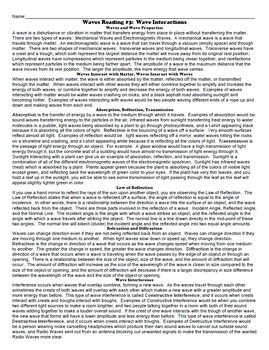
Waves Reading #3: Wave Interactions
This resource is a Read, Think, and Draw of Waves Reading #3: Wave Interactions- Absorption, Reflection, Transmission, Law of Reflection, Refraction, Diffraction, Constructive Interference, and Destructive Interference. Through the reading students will learn about: What is a Wave?, Two Types of Waves (Mechanical and Electromagnetic), What is a Medium?, Two Wave Shapes (Transverse and Longitudinal), What is Amplitude?, how to measure amplitude, Crests and Troughs, Compressions and Rarefactions,
Subjects:
Grades:
6th - 12th

Physics Friction, Forces, and Newton's Laws Vocabulary Study Guide
- This is the vocabulary sheet that my students use when we go through Friction, Forces, and Newton's Laws.
- I always print the vocabulary sheets single sided so once students have written in the definitions then they can write numbers on the back to turn the vocabulary sheets into a matching game that will make studying the vocab more beneficial.
- This vocabulary set includes 20 key words.
- I have included in the answer key for the vocab sheet as well.
- This could easily be modified to cr
Subjects:
Grades:
8th - 12th
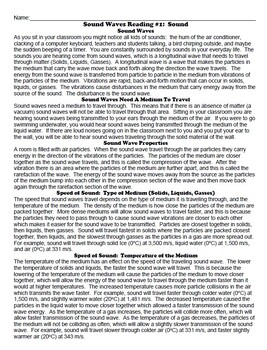
Sound Waves Reading #1: Sound Waves, Speed of Sound, Mediums, Temperature
This resource is a Read, Think, and Draw of Sound Waves Reading #1: Sound Waves, Mediums To Travel Through, Sound Wave Properties, and Speed of Sound. Through the reading students will learn about: What are Sound Waves?, Longitudinal Waves, Vibrations, Sound Waves need a medium to travel through, Compressions and Rarefactions, Sound Waves traveling through mediums (Solids, Liquids, Gasses), Dense mediums allow waves to travel faster, and Temperature and effect on speed of sound waves traveling
Subjects:
Grades:
6th - 12th
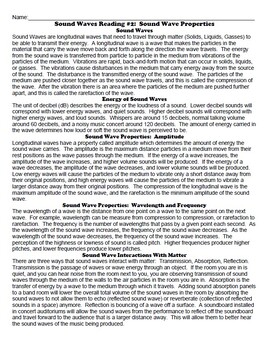
Sound Waves Reading #2: Sound Wave Properties, Amplitude, Wavelength, Frequency
This resource is a Read, Think, and Draw of Sound Waves Reading #2: Sound Wave Properties, Energy of Sound Waves, Amplitude, Wavelength, Frequency, Sound Wave Interactions With Matter. Through the reading students will learn about: What are Sound Waves?, Energy of Sound Waves (decibels), Amplitude (Compressions, Rarefactions, Energy of Wave, Relationship between Amplitude and Volume of Sound), Wavelength, Frequency, Relationship between Wavelength and Frequency, and Sound Wave Interactions with
Subjects:
Grades:
6th - 12th
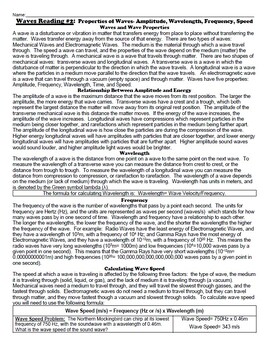
Waves Reading #2: Properties of Waves- Amplitude, Wavelength, Frequency, Speed
This resource is a Read, Think, and Draw of Waves Reading #2: Properties of Waves- Amplitude, Wavelength, Frequency, Speed. Through the reading students will learn about: What is a Wave?, Two Types of Waves (Mechanical and Electromagnetic), What is a Medium?, Two Wave Shapes (Transverse and Longitudinal), What is Amplitude?, how to measure amplitude, Crests and Troughs, Compressions and Rarefactions, the relationship between energy of the wave and amplitude, What is wavelength?, how to measure
Subjects:
Grades:
6th - 12th

Waves Reading #1: What Are Waves, Mechanical and Electromagnetic Waves
This resource is a Read, Think, and Draw of Waves Reading #1: Waves, Mechanical Waves, and Electromagnetic Waves. Through the reading students will learn about: What are waves?, types of waves (Mechanical and Electromagnetic), Waves transfer energy without moving matter, how waves transfer energy, Mechanical Waves travel through matter, Electromagnetic Waves can travel through absence of matter (vacuum) and/or through matter, Wave Shapes (Transverse and Longitudinal), Crests and Troughs on Tran
Subjects:
Grades:
6th - 12th
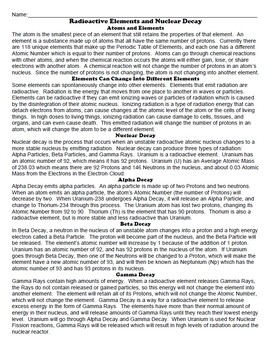
Radioactive Elements and Nuclear Decay (Alpha, Beta, Gamma): Read, Think, Draw
This resource is a Read, Think, and Draw about Radioactive Elements and Nuclear Decay. Through the reading students will learn about: Atoms and Elements, Periodic Table of Elements, Atomic Number, Atomic Mass, Atomic Mass Number, Atomic Number is Number of Protons, Effect of Chemical Reactions on Atoms and Atomic Number, Radioactive Elements emit Radiation, What is Radiation, What is Ionizing Radiation, How Radiation Changes Atoms and Atomic Numbers and Number of Protons, Nuclear Decay, Three Ty
Subjects:
Grades:
4th - 10th
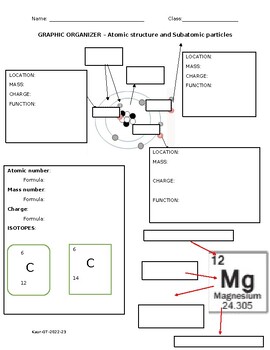
GT Chemistry - Atomic structure and Subatomic particles - Graphic organizer
Use this graphic organizer for students to take notes while they closely read and learn material on Atomic structure and subatomic particles. Students can use this tool to keep a neat, comprehensive view of information about Atoms at a glance.
Subjects:
Grades:
8th - 12th
NGSS:
HS-PS1-1

Electricity Circuit Drawing Note Stations
Teaching electricity circuit drawing and the kids need notes and references for the unit? This kinesthetic note-taking stations activity is a great way for students to create a note sheet for circuit drawing and not just copy off the board. Students move from station to station, each with a circuit symbol, definition and explanation of its function, to collect all the needed information. This document includes the graphic organizer for the students and the station notes.
Grades:
7th - 11th
Also included in: Energy Poverty, Electricity and Circuitry Unit Bundle
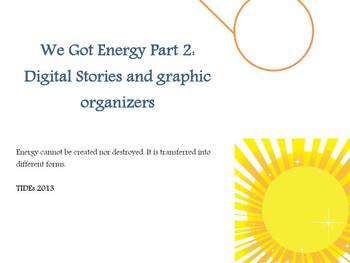
We Got Energy Part 2: Digital stories and graphic organizers
We got energy part 2 includes we got energy activity posted previously which included two activities. In part 2, the activity require students to define and distinguish between different forms of energy, classify the different forms of energy as KE or PE, identify how each form of energy is transformed and used in their community, and create a two digital story on a type of energy, energy resources and use it to teach peers.
The package includes seven assignments and resources (videos, and we
Subjects:
Grades:
5th - 10th
Also included in: All about Energy Bundle
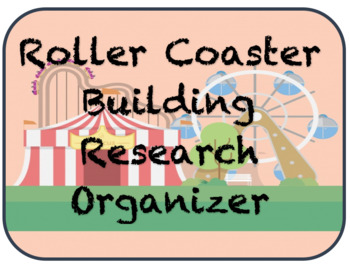
Roller Coaster Builder Research Organizer
As a way to explore energy conservation and the ideas of PE and KE, my unit summative was always to have students build a paper roller coaster! This organizer links to a Padlet with several different sources about building roller coasters, how they work and how they are designed. Students pull out information from various articles and ultimately, synthesize their understanding to create a "must have" list, which will aid in their construction of their roller coaster later.
The paper coaster re
Subjects:
Grades:
7th - 11th
Also included in: Roller Coasters! Kinetic and Potential Energy Unit Bundle

Intro to Trigonometry for Physics Lesson - SOHCAHTOA
This is a two page notes outline for an introduction to trigonometry that I use for my high school physics course. This gives students a basic overview of the SIN, COS, and TAN relationships for right triangles that students will need to work with vectors in a first year physics course. An excellent tutorial for basic trigonometry! You can teach all the trig they need for physics in one 40 minute block. Includes examples and practice for two types of trig problems.
Subjects:
Grades:
9th - 12th

Electricity Circuit Drawing Note Stations
Teaching electricity circuit drawing and the kids need notes and references for the unit? This kinesthetic note-taking stations activity is a great way for students to create a note sheet for circuit drawing and not just copy off the board. Students move from station to station, each with a circuit symbol, definition and explanation of its function, to collect all the needed information. This document includes the graphic organizer for the students and the station notes.
Grades:
7th - 11th
Also included in: Energy Poverty, Electricity and Circuitry Unit Bundle
Showing 1-24 of 91 results


